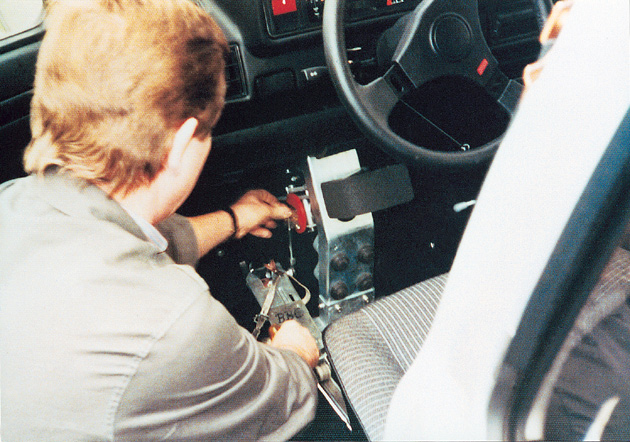
Development of Honda's Franz System Car(1982)
 |
|
An engineer adjusting the steering pedal of the Franz System Car at BBC's Mannheim Plant.
|
Honda cars equipped with Techmatic driving-assistance devices for the handicapped went on sale beginning in 1976, and were drawing considerable attention from physically challenged people. This was a significant development, since disabled persons could at last realize the benefits of personal transportation, which would ultimately help them resume their place in society.
Tetsuya Tokawa, a sales representative at Honda Higo (currently Honda Clio Kumamoto), was consulting his physically challenged customers. A willing assistant under circumstances such as these, he would often make trips to the Kumamoto Prefectural Police in order to inquire about driver's licenses, or to the Welfare Section at Kumamoto City Hall to apply for subsidies.
Through his dealings with disabled persons, Tokawa began to see the need for a special organization through which safe, convenient driving could be promoted throughout all communities where people lived with such physical difficulty. Such an organization would help them regain their independence and enjoy more fulfilling lives. However, at the time it was still difficult for the physically challenged person to get a driver's license due to regulatory hurdles. Tokawa was hoping that organized programs to promote safe driving would lead to improvements in licensing.
Tokawa went to his boss, Masanori Soga-the president of Honda Higo-with his idea. To his great pleasure, Soga not only welcomed the idea of establishing such an organization, but advised him on how they could design an organization that would help physically challenged persons enjoy the benefits of automobile ownership. Tokawa inaugurated the Safety Club Higo on March 5, 1978, based on advice from Soga and Honda Motor's Office of Safe Driving Promotional Operations, and with help from Kumamoto Prefectural Police Headquarters. Representing the Prefectural Police, Sosuke Kawakami, vice-head of the Traffic Police Squad, attended the inauguration ceremony as a guest of honor.
"There were some concerns at first," Kawakami said, "because the club was starting out rather small in scale. However, in observing their activities those concerns soon disappeared. Instead, we joined in discussions with club members, examining ways to ensure a safe lifestyle for physically challenged persons."
The club's seventy members were mostly residents of Kumamoto Prefecture who had physical challenges. The club began its operation with the goal of fostering friendships among the members and promoting regional traffic safety. Specifically, the members used the facilities of the Fukuoka Traffic Education Center to learn the facts and skills required for safe driving.
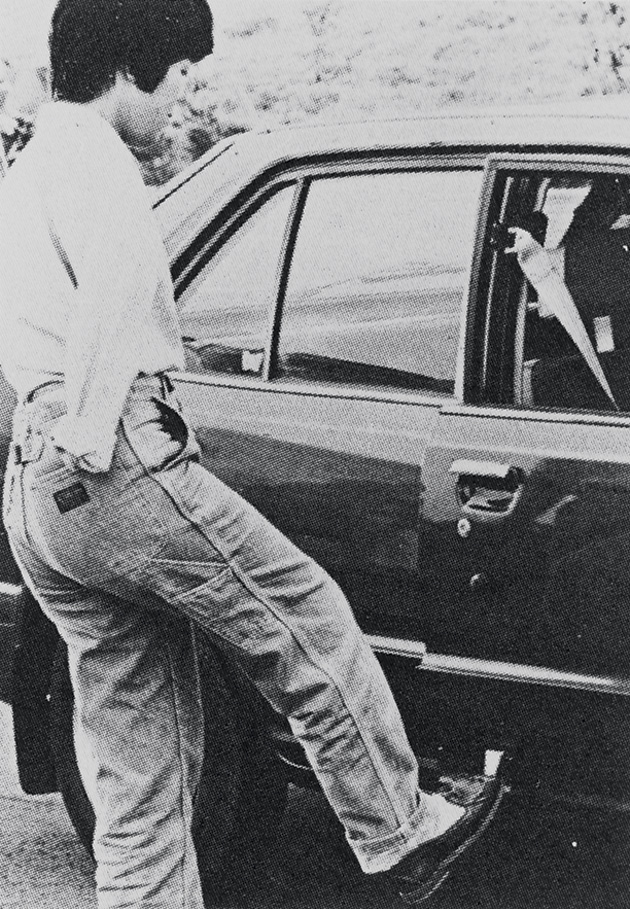 |
|
Noriko entering Japan's first Franz System car, which was equipped with an array of assistance devices
|
It was early in April 1980 when a newspaper article caught Tokawa's eye. It was about Noriko Tsuji (now Noriko Shirai), a victim of thalidomide-poisoning with ill-formed arms. The article reported on her appointment to the Welfare Section at Kumamoto City Hall. Because she was rather diminutive, Noriko had been known to the Japanese by the affectionate nickname "Nonchan."
Each time his work brought him to the Welfare Section where Noriko worked, Tokawa would greet her and encourage her to join Safety Club Higo. He was genuinely attracted to her personality, and wanted to be there as a friend when she needed someone with whom to talk.
"At that time, getting her a driver's license hadn't crossed my mind," Tokawa recalled.
Takeo Matsumoto, a manager at Honda Motor's Public Relations Department, visited the Press Club early in January 1981. There he was asked by Masayoshi Yoshikawa, a reporter with the Yomiuri Shimbun who was writing an article on the Ministry of Health and Welfare, about Honda's programs for the International Year of Disabled Persons.
Matsumoto could not provide an immediate answer to the question. He also learned from Yoshikawa that other manufacturers had been approached by victims of thalidomide-poisoning and were considering the possibility of developing cars for them.
"What is Honda planning to do?" Yoshikawa asked. Those words rang in his ears for quite a long time.
An NHK program of January 12 entitled, "A Departure: Kozue's New Challenge on Her 20th Birthday," was broadcast nationally. In the program, a segment featuring thalidomide sufferers in England and West Germany, who were using their feet to drive cars in cities there, created a sensation among the public. One member of Safety Club Higo, who saw the program, suggested at a meeting that they should also assist Nonchan to let her drive a car. The proposal created a real sense of excitement among the members.
Noriko recalled how she felt upon hearing the idea: "I was surprised when I first learned there was a car you could drive with your feet. But then I thought I might be able to drive one myself. Since I am by nature very curious, I had a strong desire to get a driver's license if it was at all possible."
No one, though-not even Tokawa-had come up with a specific plan. The club, which had initiated the plan, was left with no alternative but to ask Honda for help. Soga, too, offered some assistance, contacting the Office of Safe Driving Promotional Operations and explaining the situation.
Consultations regarding the matter were already the subject of discussion at Honda Motor's Office of Safe Driving Promotional Operations. Even Masayuki Yoshimura, a manager there, knew of the request. However, persons without full use of both upper extremities or those without both arms above the elbow were prohibited from driving.
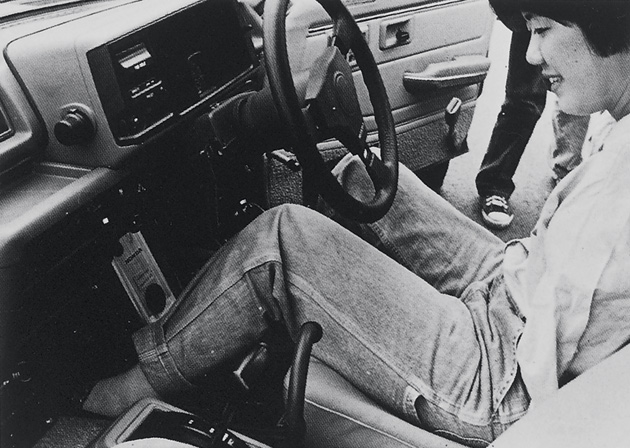 |
|
Several ideas were adopted for the Civic's driver seat, which was surrounded by several thoughtful assistance devices.
|
A New Year's ceremony was held by the Sales Division at Tokyo's Hotel New Otani in mid-January 1981, with Tokawa and Soga in attendance. At the event, Tokawa spoke to Tadashi Kume, the president of Honda R&D. "Mr. Kume," he said, "there is a woman who works at Kumamoto City Hall. She is a thalidomide victim who is physically challenged person. The members of our club saw a TV program early this year featuring a car that could be operated using only the feet. And now, the club wants Honda to build a car like that. Please consider it."
Kume, seemingly surprised by the request at first, eventually promised Tokawa that he would give him an answer soon. Yoshimura, who later heard of the development, contacted Matsumoto and told him that they were being consulted by Honda Higo about building a foot-operated car, but that it was impossible under the current regulations. Matsumoto also confided in Yoshimura concerning the question he was asked in an interview with a newspaper reporter. The two decided to explore ways in which Honda could assist in the project.
Matsumoto paid a visit to Honda Higo early in February 1981, and although he had never met Soga or Tokawa he was able to express his opinion with total candor. "People with physical disability," he said, "cannot lead useful lives in society without proper means of transportation or communication. However, currently there are no cars specially designed for such people, nor any sort of road infrastructure to support such vehicles. I believe the automobile manufacturers should take the lead in changing this situation. "In 1974, Honda developed its Techmatic technology. It was the industry's first driver-assistance device for the physically disabled, and Honda began selling it in 1976. Therefore, the company's corporate commitment in this area is recognized by the physically challenged, who also have high hopes for continued achievements in this area. Using the service know-how we've obtained through our nationwide SF (Service Factory) Network, we can build a car that will successfully compete in this important category."
Soga nodded his head deep, in heartfelt approval of this positive comment by Matsumoto.
That evening Matsumoto attended a meeting of Safety Club Higo, where he saw one member help Noriko drink some juice from a can. From the natural way in which the person acted, Matsumoto knew all the members shared a common motivation: to help Noriko. Looking at her tiny mouth as she sipped thirstily at the juice, Matsumoto saw her strong determination to lead a life on her own.
Looking at Noriko's face, Matsumoto made up his mind. "We will help her," he said to himself.
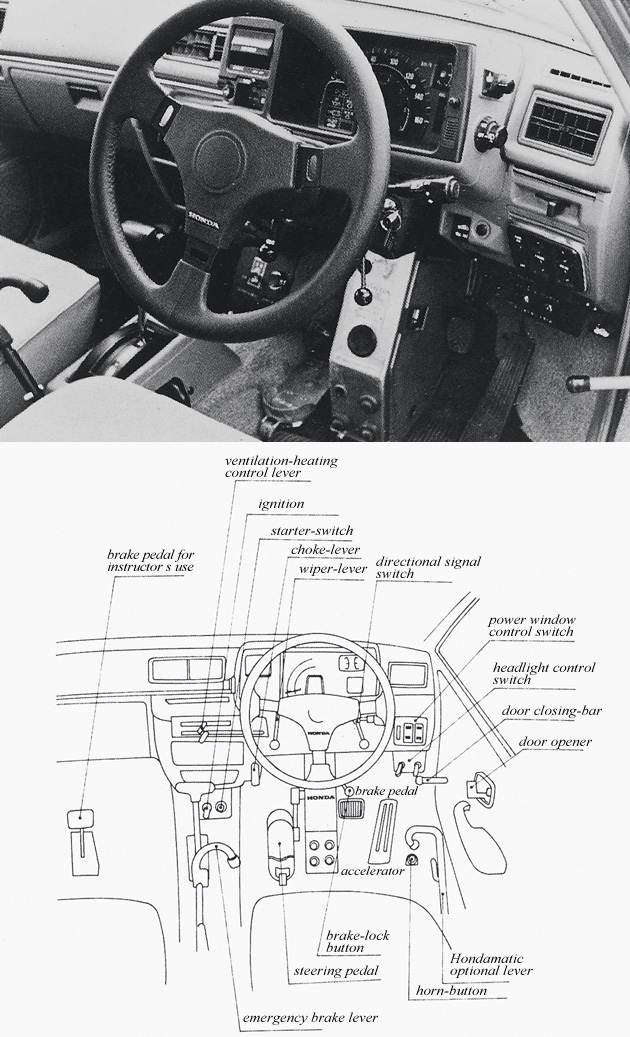 |
|
The various driver-assistance devices installed in the Civic were designed for persons who were without the use of both upper extremities.
|
Upon his return to Tokyo, Matsumoto wasted no time finalizing the proposal he had been preparing with Yoshimura. Well-timed for the International Year of Disabled Persons, the theme of their proposal was the development of a car that could help physically challenged people on their way to rightful recognition in modern society. In mid-February 1981, he and Yoshimura attended a meeting organized by Executive Vice President Hideo Sugiura, who had since late the previous year been leading a project aimed at resolving the issue of assisting the physically disabled. Sugiura had organized a group of ten or so key Honda employees representing various departments in order to determine the specific measures that Honda should take. Matsumoto and Yoshimura, also, were members of the group, so at the meeting the two explained the background and details of their proposal. Although he maintained a prudent attitude appropriate to the leader's role, Sugiura agreed with their proposal overall and encouraged them to help Noriko.
Matsumoto and Yoshimura later spoke with the heads of several departments-including Sales, Quality Assurance, the Office of Safe Driving Promotional Operations, and the Office of Public Relations-asking them to procure a budget for the research and development of a driving-assistance system for the physically disabled. Preparations to establish an environment for the development project were thus under way.
In order to study cars that could be operated with just the feet, Yoshimura contacted the Tokyo Handicapped Drivers' Association and asked for help from its Chairman Shinzo Hatanaka. Several days later, Hatanaka paid a visit to Yoshimura's office bearing documents on two different devices. According to those documents, a device developed in England employed a floor-mounted disk, which was operated by the foot in a circular motion to provide control. Approximately ten cars were apparently equipped with the device.
The West German solution was known as the Franz System, after inventor Eberhard Franz, who was an employee of the Braun Bovery Company (BBC), a manufacturer of heavy electrical equipment. Having lost both hands to an electrical accident when he was twenty years old, Franz spent nine years completing his first driving-assistance device, which was designed for persons who had lost the use of both upper extremities. The device was certified in 1965 by the Transportation Authority of West Germany and had through the course of fifteen years undergone continual improvements. To provide steering control, the device used a pedal that was operated with the left foot, just like a bicycle pedal. To date, 150 to 160 cars equipped with the device had been produced and sold in West Germany.
Yoshimura and Hatanaka were interested in the Franz device, in part because the sales quantity was larger and partly because it was developed by a person who had in fact lost the use of both upper extremities. After studying medical implications, Yoshimura contacted Matsumoto several days later and told him the Franz device was the best choice, claiming that it would fit the human bone structure and movement of the joints.
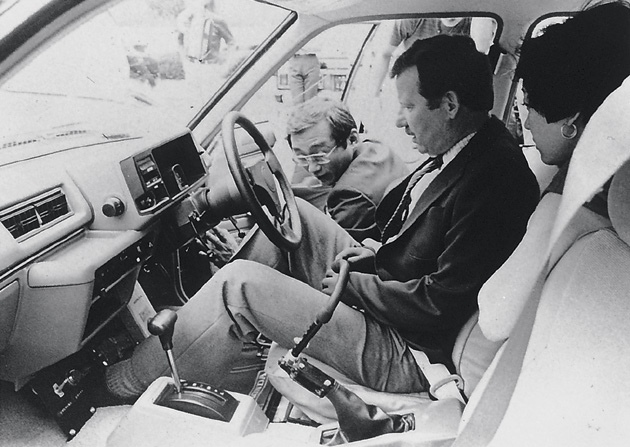 |
|
Inside the Civic, Sato (left) explains the devices to Mr. Franz (center), who is seated in the driver's position.
|
Having selected the Franz System, Matsumoto and Yoshimura contacted Honda R&D and Tech Production of Honda Land (currently Suzuka Circuit Land), an associate company of Honda Motor, and asked them to develop a vehicle. However, the immediate response was not positive, since Honda R&D, in particular, was busy with a number of projects. They visited Honda R&D several times thereafter, but no one was assigned responsibility for the project.
"We often thought of giving up," Yoshimura remembered, "since we were unable to get an answer. However, we always came to the conclusion that we shouldn't give up for Nonchan and the many other people who might benefit from such a car in the future. So, Matsumoto and I made it a point to encourage each other."
Matsumoto faxed a letter to Honda Deutschland President Mitsuo Ishihara in March of that year, requesting specific information regarding the Franz System. The letter read as follows:
"I apologize for this rather abrupt request. This year marks the International Year of Disabled Persons, and Japanese media are reporting on many topics of concern to the physically disabled. This year also sees the thalidomide babies turning twenty years old. An NHK program broadcast in mid-January featured a female thalidomide victim in West Germany who was without the use of both hands. One scene showed her using her feet to drive a car equipped with the Franz System. It caused a sensation among viewers throughout Japan. Yet today, drivers in this country are legally required to steer their vehicles using the hands. Still, a modification to the current law may be considered as public awareness increases regarding the issue. One Japanese car manufacturer has already ordered a vehicle from BBC, and it is due to arrive in March. Since the public has high expectations of Honda in this area, it is critical that we develop a car as quickly as possible. Please see if you can order a Franz System of catalogue specification. We also would like to obtain technical information regarding system installation for use in the Civic. Please let us know how long it will take to receive the system and how much it will cost. We would like to have a running Civic prototype with the Franz System by around May."
Ishihara gathered all information within two days and sent the following reply to Matsumoto on March 5:
"We need two to three weeks to get a Franz System kit, which will cost about ¥960,000. It would take approximately three months to develop a right-handle vehicle with the Franz system. The specifications can be adjusted at Honda in Japan, depending on the type of vehicle used. They can provide us with technical information, but we must pay some patent fees. You may bring Japanese-version Civics and Accords to their site."
The Japanese Government had issued a statement around that time regarding a possible revision of the applicable ordinance. On March 6, the Nikkan Jidosha Shimbun, a daily automotive newspaper, reported on the forward-looking attitude of the National Police Agency and Ministry of Transportation in revising the ordinance and associated regulations. The article quoted a comment by Hayao Ikeda, head of the National Police Agency's Traffic Bureau: "As long as there are appropriate cars," he said, "we will not hesitate to revise the government ordinance and allow thalidomide victims to obtain drivers' licenses." Moreover, Noriyoshi Uno, manager of the Ministry of Transportation's Maintenance Department, was quoted as saying, "We will consider any specific request for approval [of such a car] in a prompt, forward-looking manner."
Soon, a piece of surprising news came in from Tech Production, which had decided to put Hiroshi Sato in charge of development and production. Sato, a technical advisor, had appropriate experience through involvement in the Techmatic driving-assistance device for the physically challenged. Matsumoto and Yoshimura quickly decided to purchase a Franz System, and sent information regarding Noriko's physical characteristics to Ishihara. They also notified Ishihara that they wanted to send engineers to West Germany as soon as possible, and that they were willing to pay the required patent fees.
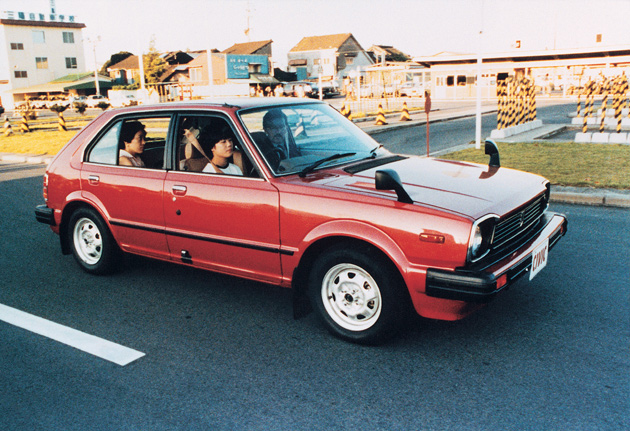 |
|
Noriko driving the Civic at Sanyo Driving School, with Franz in the front passenger seat
|
Matsumoto and Yoshimura were in attendance at a March 8, 1981, meeting of the Safety Club Higo, held in Kumamoto. Matsumoto updated the group on the progress of vehicle development, saying they would be dispatching Honda R&D's engineers to West Germany on behalf of the project. It was truly good news, showing that Honda was responding quickly to the need.
The pair then returned to Tokyo, where they received the news they had long been waiting for: Honda R&D had appointed Hideo Masui, a veteran chief research engineer, to be the man in charge of vehicle development. Matsumoto and Yoshimura immediately went to Honda R&D in Wako, Saitama Prefecture, for a meeting with Masui and Sato. They explained the background of the project and provided an overview of the Franz System, based on the available information. In becoming a project team, the four men identified their respective roles.
Key functions were laid out, as follows: Matsumoto, with his experience in the Public Relations Department, would oversee internal coordination and public-relations matters; Yoshimura would utilize his experience in the Office of Safe Driving Promotional Operations in the handling of legal issues and matters relating to vehicle arrangements; Masui would take care of overall engineering aspects; and Sato would handle the actual vehicle production.
Sato, aware that so many things were now quickly moving forward, departed for West Germany on March 23 in order to see the Franz System at work. The next day, Masui made the same trip. While in West Germany the two men inspected vehicles equipped with the Franz System, and they were able to confirm its applicability to a Honda car. Moreover, they learned how to teach students to drive a Franz System car. Later, they met with Mr. Franz in order to discuss engineering issues and convince him to approve Honda's use of the system. Franz could easily see their enthusiasm, and said he wanted Honda to make use of the system.
Meanwhile, back in Japan Franz-equipped cars purchased by another manufacturer had made a March 25 arrival. The story was sensational news in the newspapers and television broadcasts.
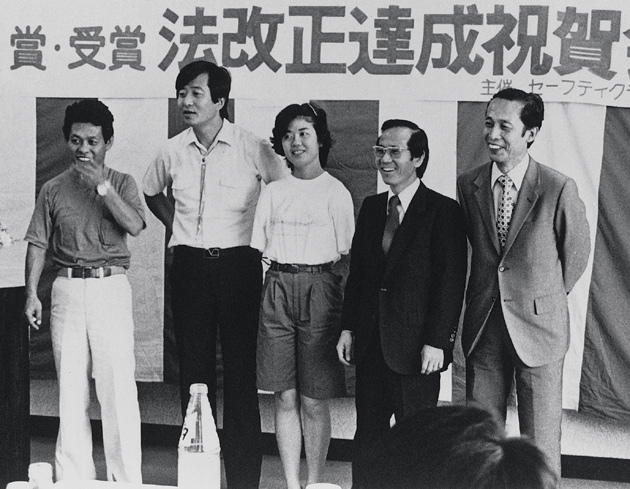 |
|
From left, Tokawa, Matsumoto, Noriko, Yoshimura, and Masui, cheered by members of Safety Club Higo at a ceremony organized by the club to celebrate the new regulation.(Photos on those days courtesy of Takeo Matsumoto and Hideo Masui)
|
Masui and Sato returned to Japan on April 6, 1981, following three weeks of exhaustive research.
Masui flew to Kumamoto immediately upon his return, the purpose of which was to visit Dr. Hiroyuki Yonemitsu, who was both the director of Kumamoto Hospital for Highly Advanced Medical Treatment, and Noriko's physician, who could verify the functionality of the device from a medical point of view.
"Dr. Yonemitsu used simple words to explain that the movement suitable for the joint at the top of the thigh was something like the action of pedaling a bicycle," Masui recalled. "His words really encouraged me. And though we had already chosen the Franz System, this supporting opinion from a medical professional gave us confidence in the engineering and viability of this system."
The Franz System kit arrived April 15, and was two days later accompanied by a presentation by the four-man project team to Tadashi Kume at Honda R&D. There the team explained the background and project details based on materials that had been prepared by Masui.
The presentation having been completed, Masui assured Kume that the specifications were free of structural problems.
Several days later Sato informed Masui of the installation schedule for the kit. According to that timetable, assembly of the basic components and custom-made parts had to be completed by May 15 and any problems adjusted by May 22. In other words, assembly and adjustment had to be completed in less than a month. Masui recognized that Sato was strongly determined to meet this objective. To stay on track, various arrangements had to be made with the related departments within Honda and the relevant government authorities. Masui wasted no time contacting Matsumoto and Yoshimura.
Preparations were well under way at Tech Production, where the Franz System was being installed on the base car, a 1,500 cc Civic with the Hondamatic power-steering system. Shuichi Sasagawa, an engineer involved in vehicle development, was working under Sato on the production of Honda's Franz System car.
"We worked overtime every day," recalled Sasagawa. "I was in charge of the steering system and auxiliary devices. We had to substitute all hand movements with foot controls, so we adopted mainly mechanical devices in order to reduce the cost and facilitate maintenance. In switching the position of steering control to the right side, we examined numerous ideas besides the steering-gear unit."
Sato and Sasagawa tackled numerous challenges within a very short span of time. Since compromises were not to be accepted, they repeated test-drives over and over until the satisfactory results could be obtained. Despite the extensive effort involved in its production, the vehicle was completed on schedule.
Honda held a two-day practice session on May 23 and 24 at the Traffic Education Center Rainbow in Okegawa, Saitama Prefecture, in order for Noriko to test-drive the Franz System Car. Observing the session were Noriko's mother Hideko, Tokawa, Katsunori Yoshisaka, the chairman of Safety Club Higo, the four project team members, and many other people involved in the development. The initial day started with an explanation of basic operation for each device installed in the car. Afterward, Sato and Masui got into the car and sat in the front passenger seat and rear seat, respectively. Noriko was then seated in the driver's seat. Drawing the attention of all present, Noriko started the engine. The Civic began to move slowly.
"Wow! It's moving!" cheered Noriko, accompanied by the many who had gathered to see her in action with the new car.
The next day, Noriko drove much better. It was hard to believe that she had never driven a car before. After all the schedules were completed without any problem, Noriko talked about the experience:
"It is such a wonderful feeling to be able to drive. At first, I thought it was difficult, but after a while I got the feel of it. The most exciting moment was when I accelerated to 60 km per hour on the course. I realized I could go anywhere if I had a car. I could be free. "I know this car isn't designed for me alone. I must try hard to lead the way for many others whose disabilities are similar to mine." (Honda company newsletter No.161, issued July 30, 1981)
An official test drive and a press conference by Noriko were held on May 29, before a large group of journalists. That evening, Yomiuri Shimbun reported the details of the test drive under a banner headline that read, "Nonchan Drives a Car," followed by the subhead "First Japanese Car for People Without the Use of Both Upper Extremities."
Having observed Noriko's practice runs, Yoshimura was fully confident that she would obtain her driver's license.
Following his return from Okegawa, Yoshimura spent the next three days June 3 through June 5 at the National Diet. He brought the car into the building and described it to the Diet members who had expressed an interest in the welfare of disabled persons. He also promoted the car at the relevant government offices, explaining its safety and control features to the relevant personnel.
Yoshimura explained the benefits of the car: First, it could be operated by a physically challenged person using his or her feet alone, and function just like any other car driven by an able-bodied person. In doing so, he stressed that neither Noriko nor the Franz System should be branded as being "special." He stressed that every person has his or her distinctiveness, but they are not all different.
"Our society," said Yoshimura in a statesman-like tone, "is made up of a variety of people: men and women, the young and the old, children, healthy people, sick people, people with physical difficulties, and so on. Who knows; some of us might even face physical difficulty ourselves, in the future. In that regard, we shouldn't think of the physically challenged as 'disabled,' but merely that they face additional challenges that the rest of us do not. We must understand their distinctiveness and provide them with assistance. The normalization of society is a process in which people with physical disability are not shunned but recognized as valuable members of society."
However, some who heard him speak pointed out the lack of emergency measures, expressing their concerns about the safety of driving and controlling such a car using only their feet.
"Discussions regarding safety often led to heated arguments, at first," Yoshimura recalled. "One person told us we should adopt an automatic mechanism for closing the hood and hatchback door," recalls Yoshimura. "However, it wasn't possible to automate everything due to the extraordinary costs. Instead, I explained to that person that if Noriko went shopping and found she was unable to close the rear door, she could simply ask a passerby to do it for her. After all, society is built on communication; it means we speak to one another and offer a helping hand. In that way, I was able to express my opinion candidly."
Yoshimura had enthusiastically tackled the job of convincing the Diet members and government officials, but meanwhile Matsumoto had decided that a test drive by Noriko in Kumamoto at the earliest possible date would enhance public awareness significantly.
Tokawa agreed with him and took the lead in setting up the necessary schedules. He even contacted the local media. A particular matter of concern was arranging a place for Noriko to get the driving instruction needed in order to get her license. When Tokawa checked with Sanyo Driving School, he received the immediate consent of the school's managing director, Minokichi Matsumi, who said, "We'll accept her; no problem. Since the lessons won't be counted as official credits until the current government ordinance is revised, we won't charge her anything to use our facility. And with her willingness, she can certainly get a license within the standard number of hours."
Driver's training had thus been arranged, so Matsumoto decided to invite Franz to Japan, hoping of course to garner additional attention from the public. On June 26, he contacted Ishihara in West Germany, and several days later received a reply stating that Franz had agreed to come. By the end of that day, Matsumoto had set up Franz's schedule for Japan and obtained approval from the related personnel. Then, on July 3, Honda invited officials from the Kumamoto Prefectural Government and premiered Honda's Franz System car prior to its official launch. The following day, the company held a training session for the instructors at Sanyo Driving School. A test drive for Noriko was organized on the July 5 by Safety Club Higo.
To arouse public opinion and push for the revision of the government ordinance, Yoshimura and Matsumoto accepted invitations to various programs organized by disabled persons' organizations. They traveled throughout Japan exhibiting the car, giving demonstrations and test drives.
Welcome news arrived from Ishihara of Honda Deutschland on August 3, 1981. Franz, who had recognized Honda's enthusiasm during the meeting in West Germany, told Ishihara he would allow Honda to manufacturer the device and use its name for the humanitarian reason of assisting physically challenged persons, under the stipulation that the cars be sold only in Japan. Matsumoto and Yoshimura were sincerely grateful to Ishihara for his understanding of their intentions and negotiating with BBC.
At 1 p.m. on August 19, Franz and his wife Lenart arrived at Narita International Airport. During their stay in Japan, which was to last until August 27, the Franzes were to hold meetings with Honda in order to exchange technical information. They also would participate in programs at locations in Tokyo, Kumamoto, and Kyoto, where they would meet groups of disabled persons and watch the car's demonstration runs.
Their Tokyo schedule now complete, the Franzes arrived at Kumamoto Airport on August 22 at 3 p.m. There they received a hearty welcome by Noriko and the members of Safety Club Higo. Franz spoke to Noriko in the lobby, saying, "You will realize how wonderful life is if you can drive to any place you desire." Later that day, Franz test-drove Honda's Franz System Car with Noriko at the Sanyo Driving School. Over the course of about an hour, during which he and Noriko took turns driving the car, he gave the engineers present a considerable amount of helpful advice. He also encouraged Noriko by telling her of his own experiences. Noriko learned that when Franz had first built the device, people in West Germany with physical disability were not allowed to operate cars. However, following a lengthy series of appeals, the government finally approved their right to drive. Franz then gave Noriko a steering pedal he had brought with him.
Franz also volunteered to test drive Honda's Franz System Car during the demonstration, at which he amazed the audience by starting the car on a steep slope with his favorite sunglasses placed behind one of the wheels. Ultimately, the car earned his full endorsement. "There is no way this car would not pass the certification test in Japan," he said.
Mr. Franz' test drive was a powerful testament to the car's functionality and value to physically challenged drivers. Through efforts such as these, the government officials began to come around concerning the issue.
Mr. and Mrs. Franz thus returned to West Germany, leaving the four team members with a considerable amount of work. Reflecting the many suggestions he had made, they repeated various tests in order to complete the body and build a second prototype. Meanwhile, Yoshimura had received a request from the National Police Agency on November 11, asking Honda to participate in a vehicle test. Yoshimura was told that the authority was also fulfilling its share of the responsibility, which was to review the proposed revision of the government ordinance. The subjects of the vehicle test included cars developed by Honda and other manufacturers. Technical tests were thus conducted from November 16 through 19 by official examiners at the Metropolitan Police Department's test center in Fuchu. Then, on December 18, a driving test was held by personnel from the National Police Agency at Okegawa's Traffic Education Center Rainbow.
A variety of items were tested and reviewed at Fuchu, including vehicle performance and the method of driver instruction. To check the car's response, straightforward mobility, performance in making right/left turns and starting on slopes, emergency braking, rough-surface control, ease of entry/exit and emergency starting were examined.
On November 22, Yomiuri Shimbun (Western edition) printed a large headline that read, "Road Traffic Act to Change Early Next Year." The article quoted a comment by Tatsuo Ohashi, an assistant to the Vehicle Section of the Service Department at the Ministry of Transportation's Bureau of Automobiles, stating, "As long as there are cars operated by people who cannot use both legs, there is no reason to deny cars designed for people unable to use both hands. Of course, the certification test could take longer, because we have never before had cars like these. However, approval could be given at the end of the year or early next year."
Tsuyoshi Ogawa, administrative secretary at the Driver Licensing Section of the National Police Agency's Traffic Bureau, said of the revision to the ordinance, "We're presently reviewing the matter in a positive, forward-looking way, in order to allow (people who have lost the use of both arms) to obtain drivers' licenses."
The newspaper also reported that (the National Police Agency) was requesting information from manufacturers regarding their modified cars, while gathering the data necessary to confirm whether persons without the use of both upper extremities could safely drive under various conditions. The article said the matter was soon to be presented to the Study Committee on Drivers' Fitness Issues, an advisory body of the National Police Agency.
A final evaluation of Noriko's driving skills was conducted on February 27, 1982, at Kumamoto Prefectural Police Headquarters' Driver Test Center. The evaluation's main purpose was to check her skills in the performance of basic vehicle operations, to drive in mixed traffic, and comply with regulations.
The Kumamoto Prefectural Police wished to determine on the training subjects and hours based on their evaluation of Noriko's skills. The final evaluation was attended by officials from the National Police Agency's Driver Licensing Section and examiners from the Driver Test Center at Kumamoto Police Headquarters. The project members and associated personnel from Honda were also present.
A temporary test course was set up on the day of the evaluation in order to simulate conditions that would confirm, among others things, Noriko's driving skills on city streets surrounded by cars, along with her maneuvering abilities in the event that a pedestrian should suddenly dart in front of the car. Noriko not only demonstrated the success of the training she had received from Tokawa but also impressed everyone with her upbeat attitude. A sense of support for Noriko grew among the officers evaluating her skills that day.
A test of Honda's Franz System car was held on March 12 at Traffic Education Center Rainbow in Okegawa, before officials from the Tokyo Land Transportation Bureau, who were to review the modification for approval. Three days later road tests were carried out by technical examiners from the Metropolitan Police Department using public roads in greater Tokyo, along with sections of the Tokyo and Tokyo-Nagoya expressways. Then, on April 19, based on the test results, the Franz-equipped Civic received its modification approval from the Tokyo Land Transportation Bureau.
Honda subsequently requested the approval of vehicle modification from the Kumamoto Land Transportation Bureau on May 30. By the end of the month, Honda's first Franz System car produced in Japan had been registered. The car's license number "1982" represented the memorable year in which the efforts of everyone involved in the project had come to fruition.
On June 22, the National Police Agency submitted to the morning meeting of the Cabinet a proposal revising portions of the Enforcement Order under the Road Traffic Act. The revised regulation was promulgated on June 25 and went into effect July 7.
The document issued in June 1982 by the Driver Licensing Section of the National Police Agency's Bureau of Traffic entitled, "Revision of Article 33 of the Enforcement Order Under the Road Traffic Act with the Development of Automobiles Operated by the Lower Limbs" included the following statement:
"We have conducted repeated reviews of the current conditions of disqualification for driver's license applications, considering the recent development of automobiles that can be operated using the lower limbs. As a result, we have revised Article 33 of the Enforcement Order under the Road Traffic Act. ... persons who have lost the use of both upper extremities and thus been denied drivers' licenses under the old regulation can now drive automobiles, if such persons are free of certain impairments in the lower limbs...."
Noriko passed the temporary license test on July 9 on just her first try. Then, on July 16, she passed the final test. Recalling the good news, Yoshimura described how he felt that day:
"Noriko had undoubtedly worked harder than anyone else involved in the project. The result reflected her enthusiasm and her determination to change the social trend. For that alone, she is a pioneer. We also were supported by the positive attitude of government authorities and the passion of the people involved at Honda. It was an example of success, in which everyone worked to achieve this wonderful result."
Honda received a commendation from the Ministry of International Trade and Industry in May 1983, honoring its achievement in the development, manufacturing, and supply of automobiles for physically challenged persons (lacking the use of both upper extremities). Honda's Franz System car, developed through the determined efforts of so many people, continues to be produced today.